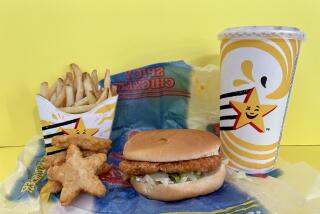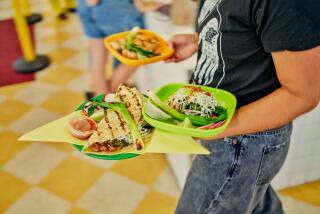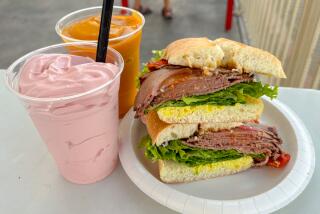‘Lite’ Heading Usually Means It’s Fit to Eat : Health: A consumer group’s study finds that restaurant chains’ low-calorie, low-fat menu offerings really are better for you--if you don’t count the salt.
- Share via
WASHINGTON — Go ahead, order the Dagwood sandwich, the Sonora burrito or even the Cajun cod. Just make sure they’re from the “guiltless,” “lite” or “fit” side of the menu.
A study released Wednesday by a consumer group concludes that leading restaurant chains’ low-calorie and low-fat meals are, as promised, much more healthful than regular fare.
But the Center for Science in the Public Interest also says that most lighter menu items contain a lot of sodium--sometimes more than the regular-menu version of the item.
Still, said Jayne Hurley, senior nutritionist for the group, “these meals are far better than similar items ordered off the regular menu. In general, you get fewer calories, less fat and saturated fat, and more vegetables.”
The center tested the food of seven restaurant chains and found that 13 of 17 items on “diet” menus were indeed more healthful and lighter than regular fare. Some chefs, though, added unadvertised fat--one, for instance, decided to put bacon bits into a “light” chicken salad.
The four items that were not more healthful derived more than 30% of their calories from fat, exceeding the government-recommended maximum.
“We are giving these companies an A for effort, but clearly they need to do a better job of communicating with the thousands of cooks and servers at their restaurants,” Hurley said.
The related Mexican restaurants El Torito and Chi-Chi’s were cited for having used too much fat--50% more than advertised at 18 grams--in their “lite” chicken fajitas. Even so, the dish’s calorie count came in significantly lower than that of the regular menu item.
“There are natural variations in the raw materials because our products are prepared by people, not machines,” said Gayle DeBrosse, the chains’ vice president of quality assurance. “But we have been recognized for making progress in providing healthier options for consumers, so we’re pleased.”
TGI Friday’s “lite” Pacific Coast tuna got the most praise, coming in at 520 calories, just 9% of those from fat. The survey calls the dish “one of the healthiest restaurant meals we’ve ever analyzed.”
The chain’s “lite” Dagwood sandwich, a vegetarian version of the sky-high creation of the comics page, logs in at 510 calories, with 29% of those from fat. That compares to a typical vegetarian sandwich with cheese, containing 750 calories, 48% of them from fat.
Bruce Silverglade, an attorney for the Center for Science in the Public Interest, said the group, which helped win passage of the Nutrition, Labeling and Education Act, has renewed a federal lawsuit seeking to have the Food and Drug Administration complete its “truth-in-menu” rules.
In 1993, the FDA wrote regulations requiring restaurants that boast of having light, healthful foods on their menus to back up those claims with information--the same sort of data on food packages.
The rules never took effect.
More to Read
Eat your way across L.A.
Get our weekly Tasting Notes newsletter for reviews, news and more.
You may occasionally receive promotional content from the Los Angeles Times.










